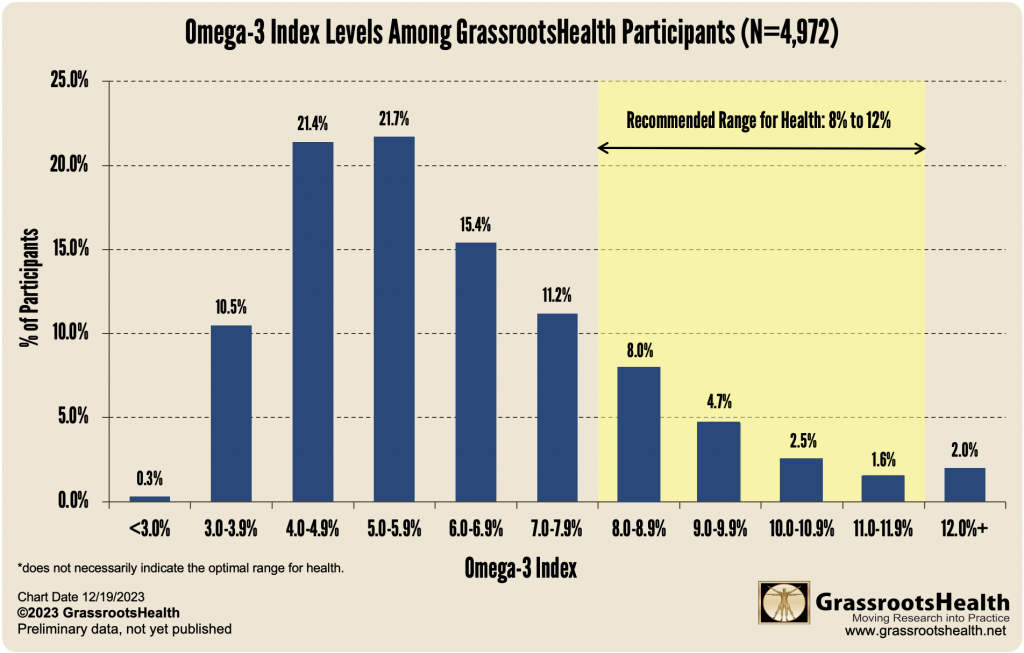Published on December 25, 2023
A Gift for You, Save 15% Today and Tomorrow Only! More than 80% of participants testing their Omega-3 Index are below the recommended 8%
Key Points
-
- More than 80% of our participants who measure their Omega-3 Index have a level below 8%, the minimum level recommended by omega-3 scientists for optimal health; this includes many who are already taking omega-3 supplements
- The average Omega-3 Index of the 2,025 participants who had tested more than once was 6.7%, almost a whole percent higher than the average index of 5.8% among the 2,948 participants who were testing for their first time
- Measuring the AA:EPA and Omega-6:Omega-3 Ratios can help you determine if you are getting a good balance of anti-inflammatory and pro-inflammatory fatty acids, and whether decreasing the intake of omega-6 fatty acids may also be necessary for improving your health; utilizing these tests together with the Omega-3 Index can also provide guidance to specific dietary changes that could support improvements in chronic inflammation and disease
- Save 15% when including any measurement for omega-3 status in your test kit with code Omega3s, now through 12/27/23
Add Omega-3s to Your Home Test Kit Here
 Omega-3s play an important role in cardiovascular, reproductive, cognitive, and emotional health, and are linked to improved mortality and healthier aging. Omega-3s can be found in fish (EPA and DHA) and in plant oils such as flaxseed and soybean (ALA). The omega-3s found in fish (EPA and DHA) have been linked to the most health benefits. These benefits include a lower risk of cardiovascular disease, dementia, depression, asthma, inflammation, and cancer. Omega-3s can also help treat symptoms of lupus, arthritis, and dry eye disease.
Omega-3s play an important role in cardiovascular, reproductive, cognitive, and emotional health, and are linked to improved mortality and healthier aging. Omega-3s can be found in fish (EPA and DHA) and in plant oils such as flaxseed and soybean (ALA). The omega-3s found in fish (EPA and DHA) have been linked to the most health benefits. These benefits include a lower risk of cardiovascular disease, dementia, depression, asthma, inflammation, and cancer. Omega-3s can also help treat symptoms of lupus, arthritis, and dry eye disease.
Since mid-2017, GrassrootsHealth has offered a home blood spot test for the Omega-3 Index, a measurement of the amount of EPA and DHA in red blood cell (RBC) membranes. This measurement reflects long-term (about four months) intake of EPA and DHA from food and supplements. Evidence suggests that achieving an Omega-3 Index of at least 8% is optimal for health whereas an index of less than 4% is deficient, particularly as it relates to cardiovascular disease.
Have you taken advantage of the home blood spot test to measure your omega-3 status through GrassrootsHealth? Do you know what steps you want to take after receiving your results? Do you know if the steps you have been taking are working?
 Measuring your omega-3 status using the Omega-3 Index can give you a clear picture of whether or not you are getting enough omega-3 fatty acids on a regular basis. Including the AA:EPA and Omega-6:Omega-3 Ratios can help you determine if you are getting a good balance of anti-inflammatory and pro-inflammatory fatty acids, and whether decreasing the intake of omega-6 fatty acids may also be necessary for improving your health. Utilizing these tests together can also provide guidance to specific dietary changes that could support improvements in chronic inflammation and disease.
Measuring your omega-3 status using the Omega-3 Index can give you a clear picture of whether or not you are getting enough omega-3 fatty acids on a regular basis. Including the AA:EPA and Omega-6:Omega-3 Ratios can help you determine if you are getting a good balance of anti-inflammatory and pro-inflammatory fatty acids, and whether decreasing the intake of omega-6 fatty acids may also be necessary for improving your health. Utilizing these tests together can also provide guidance to specific dietary changes that could support improvements in chronic inflammation and disease.
More than 80% of our participants who measure their Omega-3 Index have a level below 8%, the minimum level recommended by omega-3 scientists for optimal health. This includes many who are already taking omega-3 supplements!
Save 15% on any test kit measuring your omega status! Use code Omega3s today and tomorrow only (exp 12/27/23)
Omega-3 Index Levels among GrassrootsHealth Participants
Among the 4,972 participants who had tested their Omega-3 Index (as of December 2023), the average of their most recent test was 6.2%. Almost one-fifth (19%) of participants had an Omega-3 Index of 8% or higher, leaving over 80% of participants below the target index of 8%. Of those, 27% had an index between 6.0% and 7.9%, 43% had an index between 4.0% and 5.9%, and 11% had an index less than 4%. This distribution of results is very similar to that of our last analysis, completed in July of 2020.
In addition, the average Omega-3 Index of the 2,025 participants who had tested more than once was 6.7%, almost a whole percent higher than the average index of 5.8% among the 2,948 participants who were testing for their first time. This indicates that when individuals are provided with the right information and tools, they are empowered to make changes and to take charge of their own health.
Testing AND re-testing are both important to make sure you are getting enough of the omega-3 fatty acids your body needs from your diet and from the supplements you are investing in. Read Tips for Choosing the Best Omega-3 Supplement Routine That Works for You for important information to help you decipher how to use your Omega-3 Index results to determine the best next steps to take if your level is too low – to get it up to that target range above 8%.
Have you measured your Omega-3 Status?
Do you know what your Omega-3 Index is? Check yours today, and add the Ratios for more about how to balance your Omega-3s and 6s! Save 15% on any test kit measuring your omega status! Use code Omega3s today and tomorrow only (exp 12/27/23)
Enroll and test your levels today, learn what steps to take to improve your status of omega-3s and vitamin D (see below) and other nutrients and blood markers, and take action! By enrolling in the GrassrootsHealth projects, you are not only contributing valuable information to everyone, you are also gaining knowledge about how you could improve your own health through measuring and tracking your nutrient status, and educating yourself on how to improve it.







